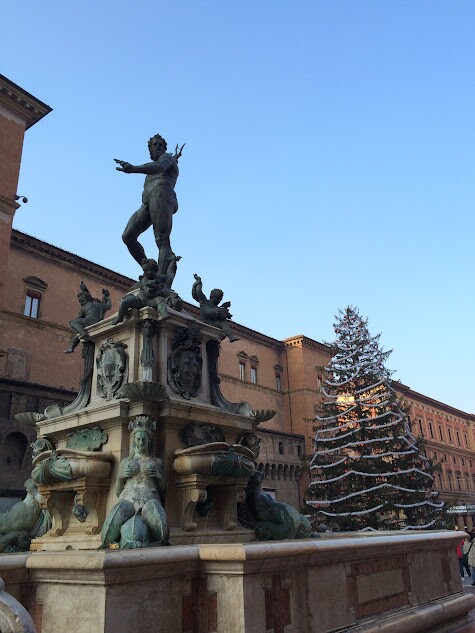Nestled in the heart of Bologna, the Neptune Fountain, or Fontana del Nettuno, stands as a majestic testament to Renaissance art and architecture. Designed by the Flemish artist Jean de Boulogne, better known as Giambologna, this iconic statue was completed in 1566 and has since been a focal point of Piazza del Nettuno. We have created a page with the best experiences to do in Bologna make sure to check that out too.

The Historical Significance
The Neptune Fountain was commissioned by Pope Pius IV in the mid-16th century to beautify the newly created square. Its primary purpose was decorative, but it quickly became an essential part of daily life in Bologna. The statue served practical purposes, aiding local vegetable sellers and washerwomen with their daily chores, which involved using the fountain’s water.
Architectural Marvel
The statue of Neptune is an imposing bronze figure standing 3.4 meters tall, weighing 22 quintals. It is not just the statue itself but the entire composition of the fountain that speaks volumes about its artistic and functional importance. Surrounding Neptune are four cherubs, representing the then-known four continents’ major rivers: the Ganges, the Nile, the Amazon River, and the Danube. This not only highlights Giambologna’s mastery in sculpture but also reflects the global awareness during the Renaissance period.
The Secrets of Neptune
One of the lesser-known facts about the Neptune Fountain is the optical illusion ingeniously designed by Giambologna. From a specific angle, Neptune’s thumb aligns perfectly with his groin, creating the illusion of an erect phallus. This subtle rebellion against the church’s censorship showcases Giambologna’s cleverness and perhaps a hidden critique of the era’s moral constraints.
Furthermore, a popular student tradition involves circling the fountain twice in an anti-clockwise direction before exams, believed to bring good luck—a practice that mirrors the legends surrounding Giambologna himself contemplating his designs around the fountain.
Artistic and Political Symbolism
The fountain is not merely a decorative piece but a symbol of papal power—akin to Neptune’s command over water, the Pope was seen as a ruler over worldly and spiritual realms. This symbolic representation was a common theme during the Renaissance, where art often intertwined with political and religious messages.
Modern Day and Cultural Impact
Today, the Neptune Fountain is more than just a historical monument; it is a cultural icon that has witnessed centuries of history unfold around it. It remains a popular meeting point for locals and tourists alike, and its image is frequently used in promotional materials showcasing Bologna’s rich cultural heritage.
The fountain has also inspired various local legends and modern-day celebrations, reflecting the community’s attachment to this masterpiece. It not only enhances the aesthetic value of Bologna’s urban landscape but also continues to play a vital role in the social and cultural activities in the city.
Why Tourists Should Pay Attention
Visitors to Bologna should pay special attention to the Neptune Fountain not only for its historical significance but also for its detailed artistic expression and the fascinating stories embedded in its structure. Tourists can appreciate how Giambologna’s work compares with other Renaissance art, such as the Neptune Fountain in Florence. While Bologna’s fountain showcases a more dynamic interaction with the public space and a playfulness in its design, Florence’s version, created by Bartolomeo Ammannati, focuses more on the grandeur and power of Neptune, fitting its more formal and imposing setting in the Piazza della Signoria.
In conclusion, the Neptune Fountain in Bologna is a profound emblem of the city’s artistic heritage and historical significance. Whether you are drawn to its historical allure, architectural grandeur, or the secrets it holds, a visit to this remarkable statue offers a glimpse into the soul of Bologna, making it a must-see for anyone traveling to this storied city.
Discover more from Emilia Delizia
Subscribe to get the latest posts sent to your email.